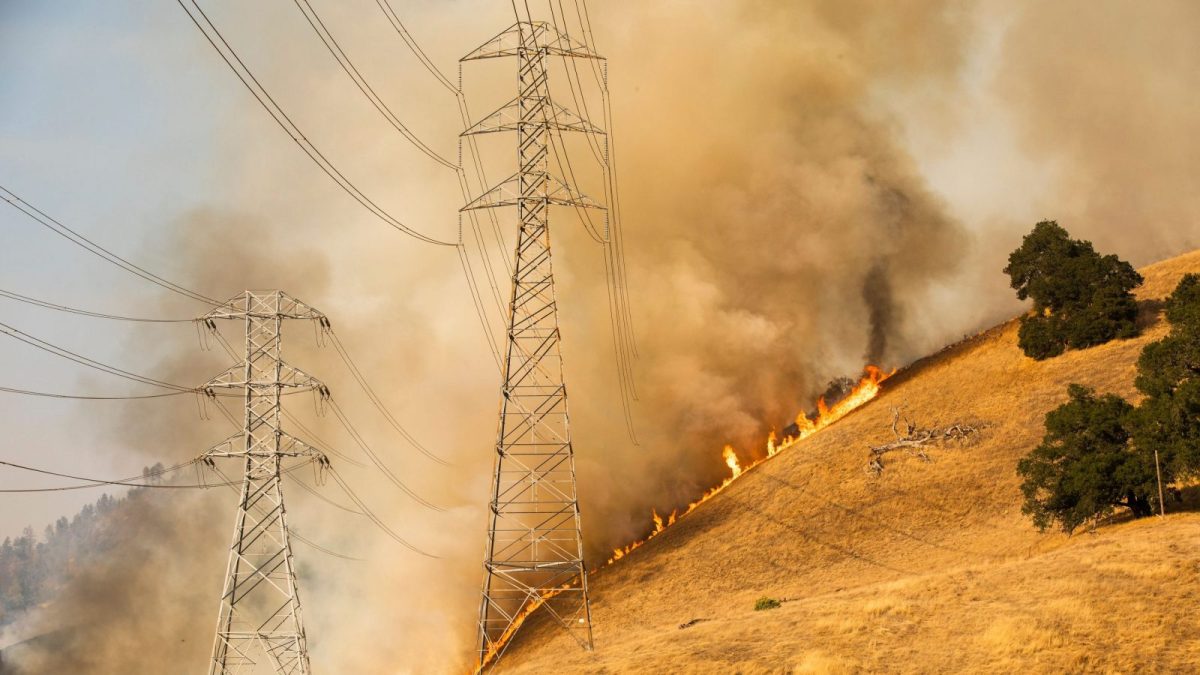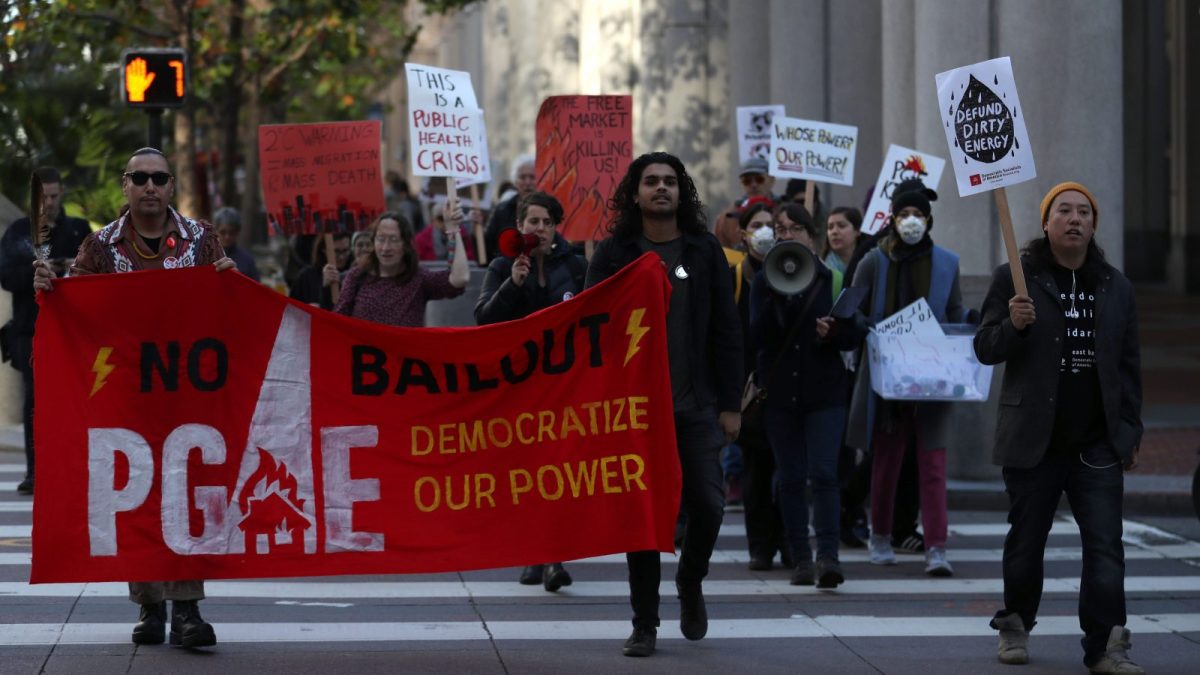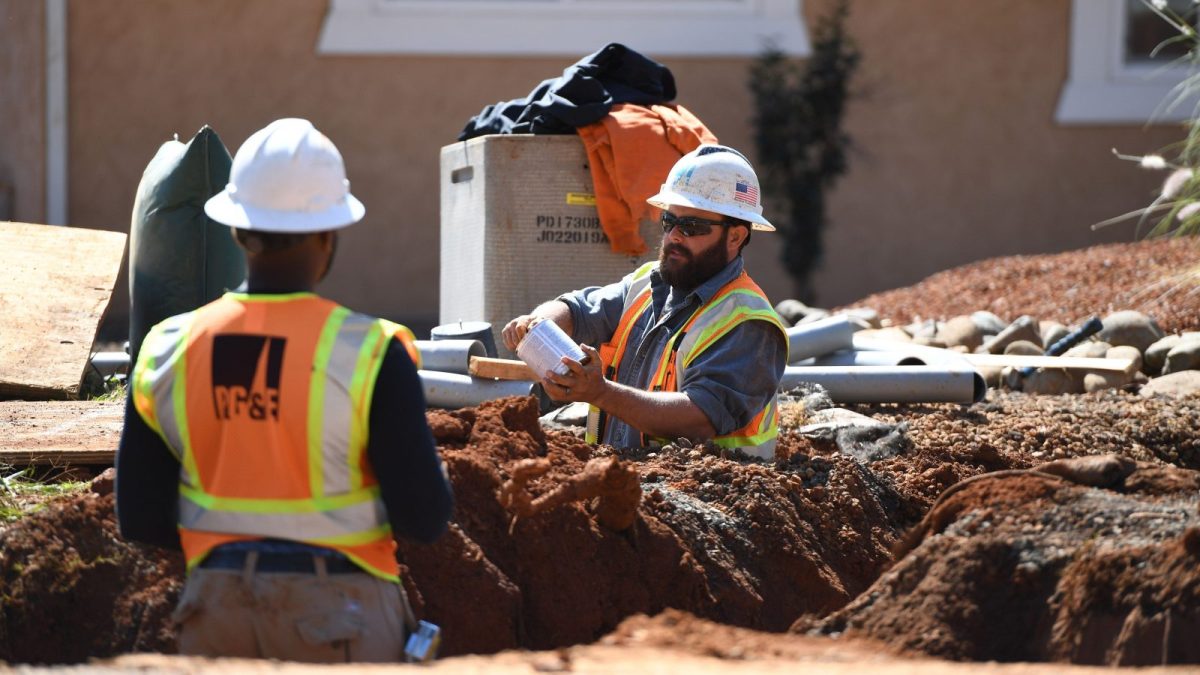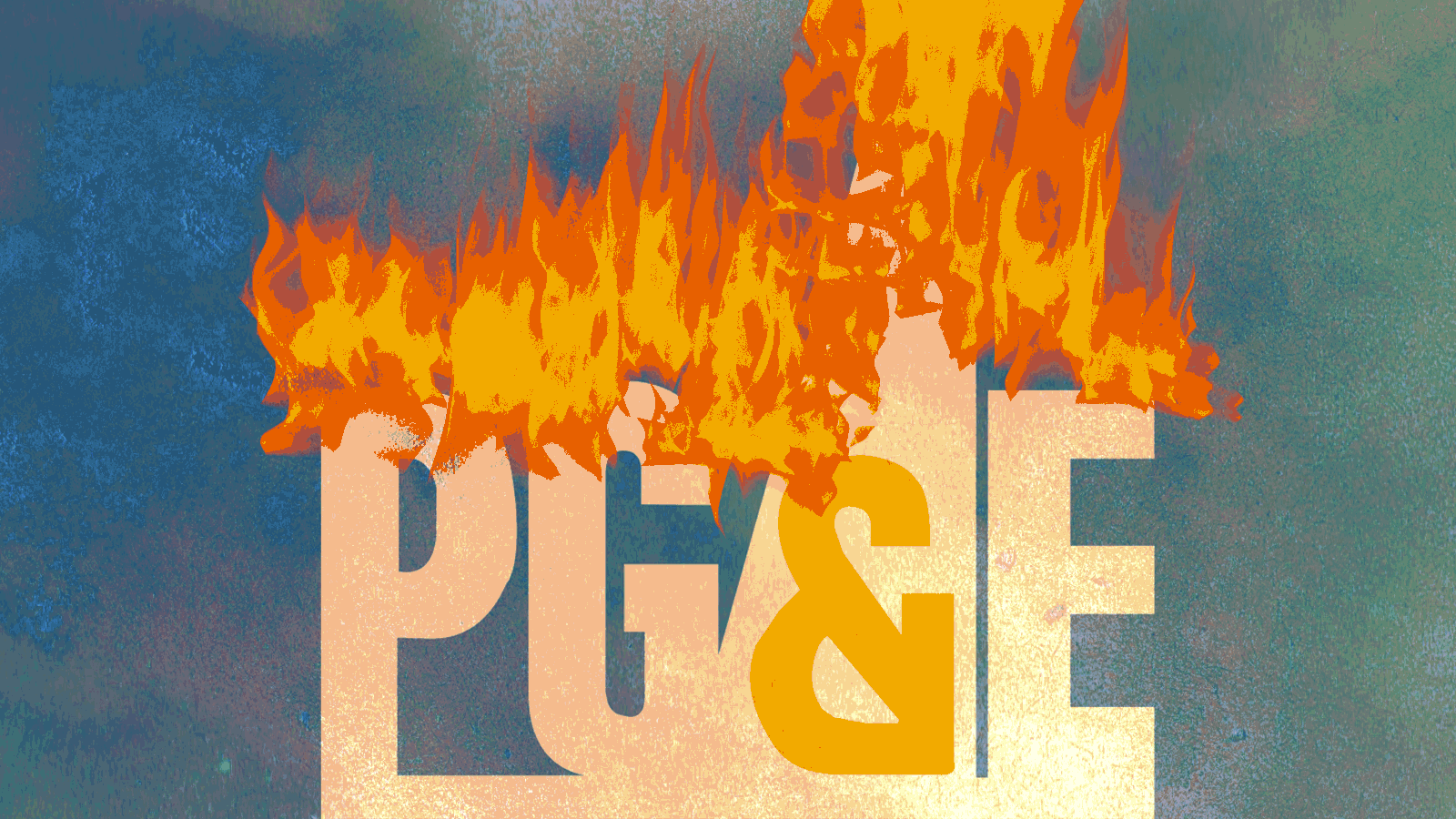For the last 150 years, Pacific Gas & Electric has been playing political hardball to maintain its monopoly over California’s electricity.
PG&E, now infamous for its connection to wildfires and power outages, started life in 1852, when three brothers — the Scots-Irish Donohues — began laying gas pipe through the muddy streets of Gold Rush-era San Francisco. Over the following decades, the company swallowed rivals, growing into an investor-owned giant with a monopoly on the power and gas lines to the cities of Northern California. PG&E’s growth mirrored that of California’s in the early decades of the 20th century, as the former colonial outpost once pillaged for treasure morphed into a self-sustaining powerhouse. It was the era of massive public projects — the Golden Gate Bridge, the Hetch-Hetchy Dam in Yosemite — bound together with a web of rails and blacktop to form the foundation of what would become the fifth-largest economy in the world.
To power this growth, the state needed electrons in a hurry, a task delegated to PG&E. California allowed the utility to have a monopoly on electricity sales to most of the state until the 1930s, when the federal, state, and local governments laid out a plan for massive hydroelectric dams. The company fought back, protesting that public power was “socialistic and un-American,” according to the historian Norris Hundley Jr.’s book, The Great Thirst. PG&E proposed a compromise: Go ahead and build the dams, but give us exclusive rights to move and sell this hydroelectricity. The state went for it.
The only hole in PG&E’s dominance of California’s electricity market came from Sacramento’s vote in 1924 to create a municipal power company. Other cities failed in such efforts, including San Francisco, where city officials tried several times to break free and start a city-owned utility. Each time PG&E fought back and won.
This continued all the way up to the present. In 2008, PG&E defeated a push by locals for San Francisco to study whether public power would work. During that campaign, the utility had an ally in Mayor Gavin Newsom — now California’s governor — who has received hundreds of thousands of dollars in campaign donations over the years from PG&E. Last year, PG&E spent more money lobbying in California than any other organization — business, union, nonprofit, you name it. For most of PG&E’s history, it was hard to imagine that California would ever consider breaking up with its largest power provider.
A series of catastrophes changed that. In 1997, a jury court ruled that the utility was responsible for burning down part of the Northern California town of Rough and Ready three years before. Prosecutors presented evidence that the company had diverted millions from tree pruning, which might have prevented the fire, into profits every year. Last year, a PG&E power line ignited the Camp Fire, which killed 85 people, making it the deadliest wildfire in the state’s history.
“PG&E has been implicated in close to 100 deaths,” said Mindy Spatt, communications director for the nonprofit The Utility Reform Network. “They have been found criminally negligent again and again.”

A back fire set by fire fighters burns a hillside behind Pacific Gas and Electric power lines during firefighting operations to battle the Kincade Fire in Healdsburg, California on October 26, 2019. – Photo by PHILIP PACHECO / AFP via Getty Images
In January, PG&E filed for bankruptcy after it became clear the company couldn’t afford to pay the billions it would likely owe to the victims of wildfires. And it’s recently drawn widespread ire for shutting off power to more than 2 million Californians. Several times this fall, residents of dozens of cities had to switch on flashlights and generators when PG&E cut the electricity to prevent fires. Food spoiled in fridges, and tempers flared. Though that might have avoided some blazes, PG&E told regulators that one of its transmission towers had broken near the ignition point of the Kincade Fire in Sonoma County, which forced nearly 200,000 people out of their homes last month.
PG&E is now in such a mess that many see it as an opening to rebuild it into something better. Newsom said last month that he wants to overhaul PG&E so that it’s “a completely different entity when they get out of bankruptcy.” Mayors from 22 cities representing 5 million Californians signed an open letter to Newsom and state regulators proposing that PG&E become a cooperative, owned by its customers. A state senator is introducing a bill to turn it into a state-run utility.
With climate change likely to stoke more wildfires, customers are clamoring for a more functional utility to adapt to a hotter, drier California. The goal is to build a power provider that doesn’t burn down its customers’ houses or leave them in the dark (at least, not so often). And seemingly every special interest out there — big business, anti-nuclear activists, solar industry groups, environmental advocates — also sees a restructuring as an opportunity to help their cause.
It can be hard to take the long view while people are losing power and homes are burning, said V. John White, head of the nonprofit Center for Energy Efficiency and Renewable Technologies, or CEERT. But focus on the latest bad news and you miss the larger forces at work, the root causes of the current mess. “We’re in some rough water right now,” White said. “But this is the time when we need that 10,000-foot view.”
The utility that eventually emerges from bankruptcy will be a different beast. It could be broken up, sold to the highest bidder (Newsom wants Warren Buffett to buy it), taken over by the state, or morph into something else. Here are a few scenarios for what could lie ahead for PG&E.
Break the monopoly grip
In April, California Public Utilities Commission asked Scott Hempling, a Maryland attorney who specializes in utility regulation, to suggest a fix. Hempling told the commission that part of PG&E’s problem was the direct conflict between public safety and profit. “A dollar cut from safety is a dollar added to profit,” he told the commission.
The larger problem, Hempling said, was the lack of competition from other utilities. PG&E still has a monopoly over most of California, an area stretching from the Oregon border to Bakersfield, north of Los Angeles (other utilities serve Southern California).
In the early 20th century, the state granted certain utilities the right to become monopolies “for reasons no one remembers,” Hempling explained. “The natural result? A culture of entitlement — the utility’s entitlement to remain the monopoly franchise, indefinitely, no matter how many rules it breaks, no matter how much anticompetitive conduct it carries out, no matter how many felonies it commits.”

Protesters hold signs as they march to the Pacific Gas and Electric headquarters on December 11, 2018 in San Francisco, California. Photo by Justin Sullivan / Getty Images
Hempling’s solution: Lay out clear plans for liquidating and replacing utilities like PG&E if they break the rules. California could then auction off the job to the highest bidder, hand the work over to a nonprofit utility, or do the job itself.
Change owners
Keith Taylor, who researches rural economies at the University of California, Davis, said one often-overlooked option comes with plenty of benefits: a cooperative, like The Associated Press or the food company Land O’Lakes Inc., owned by their members. Unlike investor-owned utilities, which have a fiduciary duty to maximize profits, a cooperative can return money left over to the customers who own it. When customers own cooperatives, there’s often more trust and transparency, Taylor said.
A good example exists within California: the Plumas-Sierra Rural Electric Cooperative, which serves about 8,000 people in a heavily forested, fire-prone part of the state north of Lake Tahoe. “They have been pretty aggressive about tree trimming and wildfire mitigation,” Taylor said. While PG&E was saying it just couldn’t find enough workers to pare branches back from power lines, tiny Plumas-Sierra managed it with a much smaller profit margin, albeit over a much smaller area.
In fact, rural electric co-ops serve people all around the country, in both blue states and red, accounting for 12 percent of the country’s electricity business. “There’s this massive electric co-op system with $42 billion in revenue, and they are totally left out of the policy discussions,” Taylor said. Publicly owned systems, like the one formed when the state of Nebraska took over its investor-owned utilities in 1970, are responsible for another 15 percent of the market.
But turning into a cooperative or a state-run utility isn’t a sure-fire remedy. Los Angeles gets its water and electricity from a public utility which has been plagued by corruption scandals and implicated in the ignition of wildfires.
Plan ahead
The idea that you could put PG&E on the right path by taking it away from investors strikes some as simplistic. There are plenty of for-profit utilities out there that don’t have PG&E’s problems, they say. Maybe the company just needs better management.
Take San Diego Gas & Electric. As PG&E implodes, people have pointed to the San Diego utility as an example of how to get it right. After windblown sparks from its electrical lines started a devastating fire in 2007, SDG&E started spending hundreds of millions of dollars every year on a flurry of measures to prevent future blazes. It buried some power lines underground, replaced wooden poles with steel ones, aggressively cut back trees, beefed up its maintenance regime, hired meteorologists, built weather stations, and started shutting off the electricity when it became dangerously windy. In other words, the San Diego utility took on all the work PG&E is just starting.
“Everyone’s favorite utility right now is SDG&E,” said James Bushnell, an economist at the University of California, Davis.
San Diego Gas and Electric, like PG&E, is owned by investors, and it’s also overseen by the same regulators, the California Public Utilities Commission. There are some key ways in which the two utilities differ that might explain the disparate results. Northern California is full of trees, while San Diego is mostly covered in bushes that barely reach the ankles of electrical towers, so the odds of fires sparked by power lines are much higher. And PG&E delivers energy to a region 17 times larger than the San Diego utility’s service area.
There’s no doubt that PG&E has a more difficult job. Still, with enough time, PG&E could follow the example of SDG&E.
Improved oversight
What wouldn’t require a major overhaul of one of the country’s biggest, messiest utilities? Getting regulators to do a better job. After all, the California Public Utilities Commission, a panel of five commissioners in San Francisco responsible for watching over all privately owned public utilities in the state, could have forced PG&E to complete safety measures to stymie fires. “The idea that the Public Utilities Commission is shocked and surprised is bullshit,” said White from CEERT. “The oversight of PG&E has simply not been what it needs to be.”
The commission twice allowed PG&E to collect $5 million dollars from customers to fix gas pipes around San Francisco. In 2007, the pipeline had sprung a leak, revealing cracks in the welding. That meant other sections of pipeline likely had the problem. The utility collected the money, but held off on the work. In 2010, one of those gas lines blew up, killing eight people and destroying a city block in San Bruno, south of San Francisco.
Spratt from TURN thinks the utility would improve if regulators just grew spines. For instance, the commission could demand that PG&E release more data on how it spends money. That would help prevent the utility from collecting money for public safety and then giving it to shareholders. “First and foremost it’s a regulatory failure,” Spratt said. “The public utilities commission is charged with looking over PG&E and making sure customers won’t be ripped off or killed.”
Some energy experts think regulators could do a better job if they had more staff. The five appointed commissioners are supposed to understand everything they regulate, a grab bag of business which includes buses, railroads, water systems, and ride-sharing companies like Uber and Lyft. At the very least, the regulators could stop accepting gifts from PG&E. Executives from PG&E have plied the commissioners with $200 bottles of whiskey, fancy dinners complete with mysterious guests referred to as “Charlie’s Angels,”and a lot of wine.
Mark Ferron, a former member of the California Public Utilities Commission, told the Wall Street Journal that PG&E routinely played a “cat and mouse game” with regulators. The problem is that the commission “is not a particularly adroit cat.”
Others say that regulators make an easy target. The commission has become the place for politicians to hand off tough decisions guaranteed to piss someone off, wrote Joe Mathews, a longtime California political journalist: “The PUC is full of technically proficient people, from engineers to scientists to judges, who are accustomed to getting blamed when they can’t resolve the impossible problems we send their way.”
A greener grid
In 2013, Vox’s David Roberts, then a Grist staffer, wrote about the threat utilities saw from “distributed renewable energy,” — in other words, a solar panel on every roof. Distributed generation, he said, “could lay waste to U.S. power utilities and burn the utility business model, which has remained virtually unchanged for a century, to the ground.”
Roberts was pointing out that electrical utilities would stop making money if enough people started generating their own electricity. The framing suggests utilities are the natural enemies of renewable energy. But Roberts wasn’t really saying that solar panels should kill utilities. After all, somebody is going to have to build a bigger grid and maintain power lines if the country is going to connect the windy Rockies and the sunny South with the electricity-hungry cities in the East.
While some investor-owned utilities, like Xcel in Colorado, are turning a tidy profit by building renewable energy plants, others are shifting from selling electricity to selling the transportation of electricity through their power lines. That’s the vision that White has for PG&E: “They become a poles-and-wires company, paid for their ability to enable a free flow of clean resources across the system.”
It’s not a solution that would insure the utility burns down fewer of its customers’ houses, it’s taking aim at bigger game: The transformational change needed to stop filling the atmosphere with greenhouse gases.
A utility prepared for a hotter climate should be able to nimbly shut off small parts of the grid at a time, rather than leaving whole swathes of the state in the dark, said Walter McGuire, who ran the state’s energy conservation campaign for 15 years before he retired. It should build even smaller sections, microgrids, where solar power and batteries can keep refrigerators and ventilators running even within a blackout.
To do that, it could follow the lead of Advanced Microgrid Systems, a company which has built a network of buildings and batteries in Irvine, California, that allows businesses to draw electricity from batteries rather than from the grid at peak hours when costs are high — while also providing backup power for outages. McGuire thinks these kinds of innovations will radically change what we need from electrical grids.
“As we move forward, we need to make sure we don’t just rebuild the old grid of the 1930s,” he said. “Storage, distributed renewables, demand response: We ought to consider these things, I don’t know that we are.”

Pacific Gas and Electric workers install conduit in trenches for underground electric lines in Paradise, California. Photo by ROBYN BECK / AFP via Getty Images
No matter how Northern California chooses to overhaul its electrical system, it will come with tradeoffs.
Back in January, a judge raked PG&E over the coals for failing to turn off the electricity before the Camp Fire started. But when it switched the power off for large swaths of the state in October, people noted a lack of wind in their immediate vicinity and speculated that the company did it purely out of stupidity and spite. And Governor Newsom was for the power shut offs until they proved to be unpopular. In short, PG&E is damned if it does, damned if it doesn’t.
Some experts maintain that shutting off the power was the lesser of two evils. In Southern California, where power stayed on during the same stretch of dangerous conditions, electricity might have started a fire that killed two people and forced 100,000 to evacuate.
There’s plenty of blame to go around. Even if PG&E were perfect, California would still be in deep shit, because a quarter of its people live in the forests. No utility reform will fix the pattern where coastal cities thwart homebuilding, and push sprawl into hazardous fire areas where small governments with little oversight are only too happy to bend the rules for developers.
Northern California needs a solvent utility, not just to keep the lights on but also to achieve the state’s climate goals. Solar and wind companies are depending on PG&E to make good on the higher-than-market rates it promised to pay them for $30 billion in renewable energy contracts, White said.
There’s no doubt that PG&E has had more than its share of scandals. But California has to go beyond assigning blame and come up with a better option. There’s a lot riding on that, even though non-partisan experts seem unsure exactly what the solution should be.
California has been one of the great laboratories for crafting new policies. Its experiments with auto emissions rules, property tax increase limits, and energy efficiency standards, have become national norms. Now, with the fate of a bankrupt utility giant on the line, it looks like the state is about to embark on a grand experiment once again.



